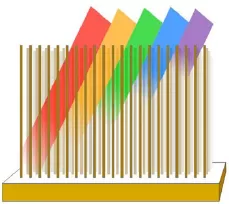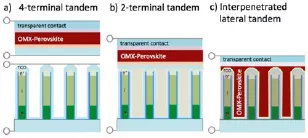Nanowire-based photovoltaics
Solar cells harvest the most plentiful renewable energy source on the planet, the sun. Geometrically enhanced light absorption in semiconductor nanowires make them interesting for the future generation of solar cells. High-efficiency solar cells use only about 1 g of material per m2.
Projects within Nanowire-based photovoltaics
Nanowire tandem cells
By use of nanowires, we have taken on the challenge to create high-performance photovoltaics (PV) at low cost, simultaneously being sustainable with concern for the limited abundance of materials on the planet. The main objective is to exploit the advantages of III-V semiconductor nanowires to develop novel PV devices with high conversion efficiency at moderate production cost. The project aims to achieve a step jump towards designing and developing a novel solar conversion system based on nanowire technology. Initially, we aim for efficiencies >20% at a fraction of the materials used in thin film technology: sustainable energy harvesting for coming generations.
The axial geometry offers greater flexibility with respect to materials combinations and we are working towards multi-junction technology where different materials are stacked on top of each other for more efficient harvesting of a larger part of the solar spectrum, combined with open circuit voltage addition of the junctions separated by Esaki tunneling diodes. This opens up the venue for even higher efficiencies >40%. Challenges are overcoming the barrier of single to tandem junction performance, control over materials composition and doping for designed p-i-n and tunneling diodes between materials in a tandem (multi) junction NW PV device, and limitations set by surface recombination leading to loss of carriers intended for carrying the current.
Nanowire/perovskite solar cells
We aim to develop nanowire-perovskite tandem junction solar cells with high solar energy harvesting efficiency. Our main focus will be to combine efficient III-V nanowire devices with emerging hybrid materials to form nanostructured tandem junctions.
This is a relatively new project where we will identify the most feasible approach to make integrated hybrid tandem devices based on III-V nanowires and solution-processable semiconductors like metal-halide perovskites. Then we will learn how to match photocurrents of sub-cells by optimizing the NW band gap and pitch as well as adjusting the perovskite band gap, assisted by numerical modeling. Laterally integrated hybrid tandem devices are considered, for which a contract strategy for perovskite-nanowire tandem junctions has to be developed in order to be able to make and test the perovskite-nanowire architectures with respect to feasibility and energy harvesting efficiency.
Hot carrier solar cells
When a photon is absorbed by a semiconductor and generates an electron-hole pair, part of the photon’s energy is converted to kinetic energy. Being able to extract work from high-energy (hot), photon-generated electron-hole pairs would create an alternative path towards high power conversion efficiencies. Nanowires are a promising system for such hot-carrier solar cells because their one-dimensional nature allows for high-power, high-efficiency thermoelectric harvesting of heat, and their geometry, combined with photonic or plasmonic effects, makes it possible to tailor the location of light absorption. A key aim of our research is to explore and understand the full potential of nanowire-based hot-carrier photovoltaics



